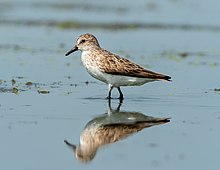| Calidris | |
|---|---|

| |
| Semipalmated sandpiper (Calidris pusilla), Jamaica Bay Wildlife Refuge | |
| Scientific classification | |
| Domain: | Eukaryota |
| Kingdom: | Animalia |
| Phylum: | Chordata |
| Class: | Aves |
| Order: | Charadriiformes |
| Family: | Scolopacidae |
| Genus: | Calidris Merrem, 1804 |
| Type species | |
| Tringa calidris[1] = Tringa canutus Gmelin, 1789
| |
Calidris is a genus of Arctic-breeding, strongly migratory wading birds in the family Scolopacidae. These birds form huge mixed flocks on coasts and estuaries in winter. Migratory shorebirds are shown to have decline in reproductive traits because of temporal changes of their breeding seasons.[2] They are the typical "sandpipers", small to medium-sized, long-winged and relatively short-billed.
Their bills have sensitive tips which contain numerous corpuscles of Herbst. This enables the birds to locate buried prey items, which they typically seek with restless running and probing.[3]
- ^ "Scolopacidae". aviansystematics.org. The Trust for Avian Systematics. Retrieved 2023-07-26.
- ^ Weiser, Emily L.; Brown, Stephen C.; Lanctot, Richard B.; Gates, H. River; Abraham, Kenneth F.; Bentzen, Rebecca L.; Bêty, Joël; Boldenow, Megan L.; Brook, Rodney W.; Donnelly, Tyrone F.; English, Willow B.; Flemming, Scott A.; Franks, Samantha E.; Gilchrist, H. Grant; Giroux, Marie-Andrée (February 2018). "Life-history tradeoffs revealed by seasonal declines in reproductive traits of Arctic-breeding shorebirds". Journal of Avian Biology. 49 (2). doi:10.1111/jav.01531. ISSN 0908-8857.
- ^ Nebel, S.; Jackson, D.L.; Elner, R.W. (2005). "Functional association of bill morphology and foraging behaviour in calidrid sandpipers" (PDF). Animal Biology. 55 (3): 235–243. doi:10.1163/1570756054472818. Archived from the original (PDF) on 2011-06-10. Retrieved 2016-06-03.